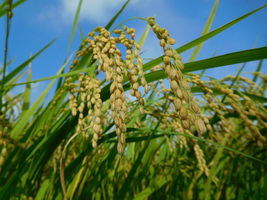
Rice 'Supercharged' with Maize Gene May Help Boost Yields
October 25, 2017| |
 To improve photosynthesis in rice and increase crop yields, scientists working on the Oxford University-led C4 Rice Project have, by introducing a single maize gene to the plant, moved towards 'supercharging' rice to the level of more efficient crops.
To improve photosynthesis in rice and increase crop yields, scientists working on the Oxford University-led C4 Rice Project have, by introducing a single maize gene to the plant, moved towards 'supercharging' rice to the level of more efficient crops.
Rice uses the C3 photosynthetic pathway, which in hot, dry environments is much less efficient than the C4 pathway used in other plants such as maize and sorghum. Scientists thought that if rice could be 'switched' to use C4 photosynthesis, its productivity will increase by 50%.
The researchers showed how they took the first step on this journey called the 'proto-Kranz' anatomy by introducing a single maize gene known as GOLDEN2-LIKE to the rice plant. This step increased the volume of functional chloroplasts and mitochondria in the sheath cells surrounding leaf veins, mimicking the traits seen in proto-Kanz species.
Professor Jane Langdale, Professor of Plant Development in the Department of Plant Sciences at Oxford University, and Principal Investigator on this phase of the C4 Rice Project, said: "This research introduces a single gene to the rice plant to recreate the first step along the evolutionary path from C3 to C4. It's a really encouraging development, and the challenge now is to build on that and find the right genes to tweak to complete the remaining steps in the process."
For more information, read the University of Oxford News & Events.
| |
Biotech Updates is a weekly newsletter of ISAAA, a not-for-profit organization. It is distributed for free to over 22,000 subscribers worldwide to inform them about the key developments in biosciences, especially in biotechnology. Your support will help us in our mission to feed the world with knowledge. You can help by donating as little as $10.
-
See more articles:
-
News from Around the World
- Nigeria Prepares for Commercial Release of Bt Cowpea and Bt Cotton in 2018
- Disease Resistant Potato Field Tests Show Positive Results in Uganda
- U.S. Lawmakers Call for Consistency in Regulating Biotech
- International Research Team Releases New Version of Sunflower Genome
- Scientists Discover Path to Improved Barley Grain Quality
- EFSA Releases Risk Assessment of GM Maize GA21 for Renewal of Authorization
- Rice 'Supercharged' with Maize Gene May Help Boost Yields
-
Research Highlights
- Confined Expression of Bt Protein in Insect Wounding Parts of Potato Plants
- Host-Induced Gene Silencing of PsCPK1 in Pathogen Enhances Stripe Rust Resistance in Wheat
-
Beyond Crop Biotech
- Stevia Plant Genome Sequence Revealed for the First Time
- CAS Scientists Develop Low-Fat Pigs
-
Announcements
- BIO-Europe 2017
-
Resources
- Biotech Country Facts and Trends
-
Plant
- Application of CRISPR-CAs9 in Chrysanthemum Using Transgenes as Targets
- CRISPR-Cas9-Mediated Gene Replacement Generates Long-shelf Life Tomato Lines
-
Read the latest: - Biotech Updates (December 17, 2025)
- Gene Editing Supplement (December 17, 2025)
- Gene Drive Supplement (February 22, 2023)
-
Subscribe to BU: - Share
- Tweet
